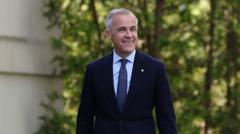Carney emphasized "decisive action" in tackling his ambitious economic strategies during the cabinet unveiling, which took place two weeks following the election. With 24 new faces, including 13 first-time MPs, the cabinet reflects a mix of established veterans from the previous administration of Justin Trudeau, such as Chrystia Freeland and Melanie Joly, alongside newcomers who are poised to address key issues like housing, immigration, and energy.
Carney has opted to maintain gender parity within his cabinet, an approach that carries on Trudeau's legacy. The new foreign minister, Anita Anand, transitions from her previous role as Minister of Defence, while seasoned MP Dominic LeBlanc shifts his focus to enhancing Canada-US trade relations. The cabinet's personnel changes come after Carney's engagement with US President Donald Trump, indicating a willingness to negotiate a new trade deal.
Notable cabinet reshuffles also include Eva Solomon as the minister for artificial intelligence and digital innovation, and Julie Dabrusin taking over as environment minister. Carney's appointment of first-time ministers to traditionally criticized departments reflects a commitment to revitalize these sectors.
While Carney promotes a cabinet designed to address the pressing needs of Canadians, Conservative leader Pierre Poilievre has criticized the retention of numerous Trudeau-era ministers as a lack of genuine change. As Canada navigates the complexities of its trade relationship with the US, this cabinet aims to bridge the gaps while addressing internal challenges faced within the country.
Carney has opted to maintain gender parity within his cabinet, an approach that carries on Trudeau's legacy. The new foreign minister, Anita Anand, transitions from her previous role as Minister of Defence, while seasoned MP Dominic LeBlanc shifts his focus to enhancing Canada-US trade relations. The cabinet's personnel changes come after Carney's engagement with US President Donald Trump, indicating a willingness to negotiate a new trade deal.
Notable cabinet reshuffles also include Eva Solomon as the minister for artificial intelligence and digital innovation, and Julie Dabrusin taking over as environment minister. Carney's appointment of first-time ministers to traditionally criticized departments reflects a commitment to revitalize these sectors.
While Carney promotes a cabinet designed to address the pressing needs of Canadians, Conservative leader Pierre Poilievre has criticized the retention of numerous Trudeau-era ministers as a lack of genuine change. As Canada navigates the complexities of its trade relationship with the US, this cabinet aims to bridge the gaps while addressing internal challenges faced within the country.




















